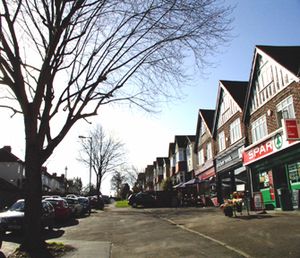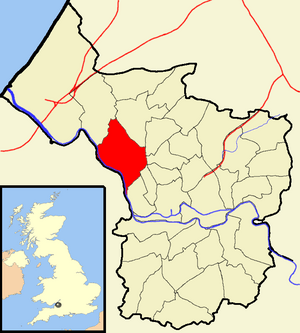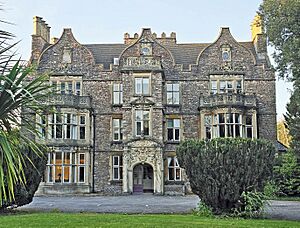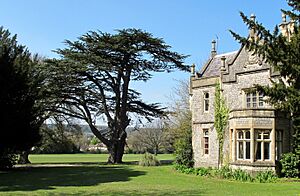Stoke Bishop facts for kids
Quick facts for kids Stoke Bishop |
|
|---|---|
 Druid Hill shops |
|
 Pre-2015 boundaries of the city council ward |
|
| Population | 9,269 |
| OS grid reference | ST563759 |
| Unitary authority | |
| Ceremonial county | |
| Region | |
| Country | England |
| Sovereign state | United Kingdom |
| Post town | BRISTOL |
| Postcode district | BS9 |
| Dialling code | 0117 |
| Police | Avon and Somerset |
| Fire | Avon |
| Ambulance | Great Western |
| EU Parliament | South West England |
| UK Parliament |
|
Stoke Bishop is a lovely suburb located in the north-west part of Bristol, England. It sits between Westbury-on-Trym, Sneyd Park, and Sea Mills. The area is bordered by the wide-open spaces of The Downs and the peaceful River Trym.
The number of people living in Stoke Bishop changes throughout the year. This is because many students come to live in the large Bristol University halls of residence during school terms. Stoke Bishop is also the name of a local council area. This area includes Sneyd Park, a big part of The Downs, and the beautiful Avon Gorge. Since 2015, it also includes most of the Sea Mills district.
Contents
A Look Back in Time
Early History of Stoke Bishop
The land of Stoke Bishop has a very long history. In the 790s, King Offa of Mercia gave this land to the Bishop of Worcester. It stayed as church property until the time of the Reformation. During this period, King Henry VIII took the land. After that, it was sold to private owners.
What we now call Sneyd Park was sold as a separate estate in the mid-1600s. For a long time, the area was mostly farmland. There were only two large houses with their own parks.
Growing into a Suburb
In the 1800s, wealthy people from Bristol started buying land here. They built big, fancy houses with large gardens. A separate church area for Stoke Bishop was created. The current parish church was finished in 1860. A grand village hall was also built in 1885.
Before 1904, Stoke Bishop was part of Gloucestershire. Then, it became part of the City of Bristol. Between World War I and World War II, the remaining farmland was sold. Many detached and semi-detached houses were built. Shops were also built on Shirehampton Road and at the bottom of Druid Hill.
The Druid Connection
Stoke Bishop has a cool connection to Druids. In 1811, an ancient stone monument was found near what is now Druid Hill. It looked like the remains of an old burial chamber. Because of this discovery, the area got its name. Druid Stoke House, a historic building, dates back to the early 1800s. The area around it was developed in the 1930s.
Important Places in Stoke Bishop
Churches and Schools
Stoke Bishop has a parish church called St Mary Magdalene (CofE). There is also a primary school, Stoke Bishop C of E Primary. It's sometimes called Cedar Park because of where it is located. Next to the primary school, you'll find the Bristol Croquet Club. This club has had many famous international members.
Community Hubs
The village hall in Stoke Bishop is a busy place. It hosts many different activities. You can find everything from dog training classes to karate lessons there.
Historic Buildings
Stoke House is the old manor house of Stoke Bishop. It was built in 1669 for Sir Robert Cann, 1st Baronet. He was a Member of Parliament and Mayor of Bristol. Today, Stoke House is a theological college called Trinity College, Bristol. It is a very important historic building.
The University of Bristol Botanic Garden moved to Stoke Bishop in 2005. It is located in the grounds of The Holmes. The Holmes is a large house built in 1879. During World War II, American Army generals used it to plan the 1944 Normandy landings.
Stoke Lodge is another historic building, built in 1836. It is now the Stoke Bishop Adult Education Centre. Next to Stoke Lodge, there is a playing field, a special tree garden (arboretum), and a children's play park. Bristol City Council has owned this entire site for education since 1947.
Sports and Recreation
Stoke Bishop is home to the Stoke Bishop Cricket Club. They play at the Coombe Dingle Sports Complex. The club has teams for adults and a junior section for younger players. These include teams for ages U9, U11, U13, U15, and U17.
Unique Homes
In the 1930s, two brothers, Jared and Jethro Stride, started building special luxury homes. These homes were in Sneyd Park and Stoke Bishop. Their sons, Arthur and Frederick, continued this tradition. Later, their sons Leslie and Raymond carried it on into the 1960s.
The 'Stride brothers' were known for building unique houses. Each house had its own design, so no two were exactly alike. They focused on good locations, high-quality finishes, and great designs. These homes often had oak floors, wood-paneled rooms, and central heating. Even today, these "Stride houses" are known for their high quality.
Roman History in Stoke Bishop
Long ago, during the Roman times, there was a harbor called Portus Abonae here. This harbor was at the mouth of the River Trym. It started as a military base. But by the early 100s AD, a civilian town had grown on the Stoke Bishop side of the river.
This town was important enough to be listed simply as Abona in a Roman travel guide from the 200s AD. It was connected to Bath by a Roman road. This road crossed The Downs and went down to the harbor. Today, you can still walk along this path, which is known as Mariners' Path.
Archaeologists have found signs of streets and shops in the Roman town. They also found cemeteries outside the town. The foundations of a small building have been preserved near the Portway entrance of Roman Way. No evidence of people living here after the Roman period has been found.
During the Second World War, bombs fell on Roman Way. One house was completely destroyed.
Notable People
- Elizabeth Ayton Godwin (1817–1889), a writer of hymns and religious poems.
- Sir Edward Payson Wills, 1st Baronet (1834–1910), a tobacco manufacturer and director of W.D. & H.O. Wills Tobacco Company.
- José Maria de Eça de Queirós (1845–1900), a famous Portuguese novelist. He was the Portuguese consul in Bristol from 1879 to 1888.
- Sir George White, 1st Baronet (1854–1916), a manufacturer of trams, motor vehicles, and aircraft. He was the managing director of the Bristol Tramways and Carriage Company and started the Bristol Aeroplane Company.



